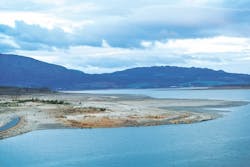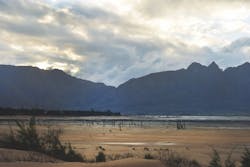Delaying Day Zero
Bob Crossen is managing editor for WWD. Crossen can be reached at [email protected].
In Cape Town, South Africa, Day Zero is a moving target. What once was seen as an inevitable has been pushed later and later in the year. However, just by virtue of having such a date indicates a deadline for a startling thought; a day when water would not freely flow from the tap of residences in the coastal city. That such a day is possible has been a wake-up call, and it has stirred conversations about how communities in similarly drought-stricken regions of the world can fend off a similar fate.
The News
When news first broke, April 22, 2018 was the date the city’s reservoir would hit 13.75% capacity and running water would be shut off to residential homes. This was called Day Zero. Critical infrastructure, most notably hospitals, would continue to receive water, and citizens would be required to visit municipal water points throughout the city to receive a set amount of water at regular intervals.
Since then, the date was pushed back to May, then June, then July, and now late August. Some projections accounting for a better rainy season have indicated Day Zero could be as late as November, and in a statement March 7, Ian Nelson, Cape Town executive deputy mayor and alderperson, was cautiously optimistic about the city’s water future for 2018.
“As this date falls deep within the normal rainfall period, it is no longer appropriate to project the date without any consideration of rainfall. Thus, provided we continue our current water savings efforts, Day Zero can be avoided completely this year,” Nelson said in the news release. “I would therefore like to urge all Capetonians not to relax their water savings efforts. While we are feeling more confident of avoiding Day Zero this year, we cannot predict the volume of rainfall still to come. If winter rainfall this year is as low as last year, or even lower, we are still in danger of reaching Day Zero early next year.”
As noted by Nelson, this looming deadline’s movement is due in part to the advent of rain, but also to stricter water use for agricultural facilities and tighter control over water for residents. In the face of all this, the biggest question is how Cape Town is battling back against water scarcity and what its plans are to stave off the imminent draw down of its reservoirs.
Volatility of Volume
Uncooperative weather patterns have instigated much of the situation in Cape Town. If it weren’t for a prolonged drought, the city may not have been making headlines for running out of water. Graham Symmonds, chief knowledge officer for Fathom, said the presumption of rainfall is not an anomaly for communities where rainfall replenishment is a critical part of the water system. Symmonds noted that similar scarcity concerns have occurred elsewhere. The assumption that rainfall will refill reservoirs have come into question.
“It’s not so much a water scarcity issue as much as it is water volatility, where you can’t depend on the past as an indicator of the future,” Symmonds said. “We’re moving into patterns of climate that are impacting historic trends and all of our infrastructure has really been built on these historic trends, and when these trends get disrupted outside the range of the engineering boundaries, then we end up in these conditions where people are running out of water.”
According to rainfall records analyzed by Dr. Piotr Wolski, a University of Cape Town Climate System Analysis Group researcher, 2012 to 2013 saw an uptick in rainfall before the drought began. Since 2013, rainfall has trended downward, with a small jump in 2016 before plummeting again in 2017. Rainfall numbers in charts posted by Dr. Wolski to GroundUp, a news agency created to distribute University of Cape Town research under Creative Commons licenses, used October as the end of the year as it marks the end of the rainy season.
Wolski took averages for one, two, three and four year records, and determined the drought in 2017 had the lowest rainfall since 1981, a 36-year low. Further analysis, he noted, shows it is the driest period since 1933. Records only date as far back as 1920, and even then, only at one weather station, but those records suggest 2017 is still the driest year in recorded weather history. Using analysis models, Wolski noted the extent of this drought period could be even more rare than the recorded data can accurately depict.
Banking on Desalination
The most critical part of Cape Town’s plan for a long-term water source for its residents relies on desalination plants to treat salt water from the ocean to remove or reduce its saline content and make it potable.
Tomer Efrat, process engineering manager for IDE Technologies, said the 10 desalination plants in South Africa have helped communities with similar challenges, but notes capacity is a greater issue.
“The output from each of these plants is small and only provides enough water for municipalities in the immediate vacinity of the plants,” Efrat said. “The reliable and effective solution for Cape Town water needs would be increasing the production of its current desalination plants, as well as promoting the installation of additional large-scale desalination plants to meet the growing water demands of the city.”
In Cape Town, there are four desalination projects in different stages of construction with delays ranging from financial backing to community stake in construction and operation of the finished facilities.
The V&A Waterfront plant was set to come on line in the second half of March 2018 with a projected 2 million liters of water per day to be treated and used as the municipal water supply. As of the beginning of March, it was the only plant on schedule.
The Strandfontein desalination plant also was projected to start moving water in late March at 2 million liters per day, but ran into delays. That initial flow was expected to increase to 7 million liters per day in May. The third plant, Monwabisi, is also intended to reach 7 million liters per day.
The Strandfontein plant is a temporary installation with a 24-month contract. If there is no renewal at the end of the contract, the desalination equipment will be removed by the contractor and the area will be rehabilitated to resemble the natural area it was prior to the temporary construction.
Additionally, there are two groundwater projects—Cape Flats and Atlantis—and a recycled water project—Zandvilet—in the works, but those three have also run behind schedule. Several other desalination projects, including barges and ships, and reclamation and aquifer programs are also listed among those for a long-term solution, but they are still in development and planning stages, according to Cape Town’s records.
Concerns from citizens have also arisen as to the nature of discharge from desalination plants back into the sea and the potential effects it may have on public safety and human health. Efrat said releasing brine back into the ocean could have an impact, but noted many desalination facilities treat the brine in some way before discharge.
“The brine outflow of the Claude ‘Bud’ Lewis Carlsbad Desalination Plant, the largest desalination plant in the western hemisphere, is blended with water discharged from the Encina Power Plant for dilution to a final salt concentration of about only 20% higher than the raw seawater salinity,” Efrat said. “Other methods, such as innovated brine diffusers may be used for ensuring efficient bring mixing with seawater.”
Learning From the West
The U.S. Southwest and California have been the poster child for water scarcity in the western world. California has seen its longest and most brutal drought since 2012, which has led to wildfires that have torn apart residences and set off mudslides. Californians have been especially water conscious since as early as the 1970s and 1980s, and that trend has only continued in the face of greater water scarcity.
Even in early 2018, the state is considering rules and regulations on wasteful water use as permanent additions to its initial 2014 resolution for drought emergency conservation regulations. These new proposals are at the behest of an executive order signed by California Gov. Edmund G. Brown, and contain proposals affecting residents, government organizations and private businesses (See sidebar, page 17).
Conservation and water has a storied history in the U.S. Southwest where companies first developed zero liquid discharge to protect waterways from power plant discharge, particularly the Colorado River that serves seven states and Mexico. Protections of that river and rights to its water have been crucial in ensuring communities not only were served, but had the means to grow.
California has also led the charge in recycled wastewater or, as it is more commonly called, potable reuse. Orange County Water District has pioneered this approach since 2008 when the Groundwater Replenishment System (GWRS) was made operational. The GWRS is the world’s largest advanced water purification system for potable reuse. It treats wastewater to replenish the Orange County Water Basin, the primary groundwater source for Orange County, rather than discharge the wastewater into the Pacific Ocean. What started as a 70 million gal per day (mgd) facility was expanded to 100 mgd in 2015 with potential capacity of 130 mgd.
The Golden State is also home to the Claude “Bud” Lewis Carlsbad Desalination Plant which first became operational in December 2015. This plant, which had been in the works for many years, has successfully provided potable water to residents. It has been recognized by the American Council of Engineering Companies and the Design-Build Institute of America for its successes (See sidebar, page 18). Efrat said it has established itself as a piece of the water scarcity puzzle in San Diego County, Calif.
“San Diego County in California is a successful case of how desalination can serve as part of a mix of solutions to meet growing water demands,” Efrat said. “The Carlsbad Desalination Plant provides fresh drinking water to about 300,000 people and generates more than $50 million annually to the regional economy.”
The benefits of these projects and policies are clear, but Symmonds noted that it has also resulted in an interesting problem for the state, an issue also noted by Meagan Mauter, assistant professor of civil and environmental engineering at Carnegie Mellon University. Because consumption has reduced, utility revenues have also dipped.
“Overall, the state did quite well of meeting the mandate of 25% reduction in consumption,” Symmonds said. “[This] was a great boon for water resources. Interestingly, it put a huge hole in utility revenue. There’s a bit of a conservation conundrum in many utilities. How do you incentivize conservation without destroying revenue?”
Symmonds said during the consumption mandate imposed by the California governor, affected utilities lost between $500 and $600 million in revenue collectively. That financial drop is difficult to swallow and creates tension with customers when the utility has to raise rates to balance its checkbook.
Financing a Solution
The successes of California’s water conservation projects have come at the cost of serious investment. The first phase of the GWRS construction cost $481 million and the Carlsbad Desalination Plant was estimated at $1 billion. Finding the money to complete desalination projects in Cape Town has been one of the stumbling blocks to getting projects finished.
“Building supply side stuff, it looks like it’s a good idea, but it really does put a tremendous amount of pressure, going forward, on your O&M with debt service,” Symmonds said. “They have half a dozen desal plants in construction right now [in Cape Town]. How is that going to affect the rates?”
Mauter said investment must take three things into account: cost, resilience and sustainability. By measuring them, Mauter said investors can find creative ways to finance projects and make them economically viable.
“Windhoek [Namibia] has a wastewater recycling plant that produced very high quality potable water for drinking and it is mixed in with other freshwater sources and delivered to customers,” Mauter said. “That technology for wastewater reuse already exists. The technology for sea water desalination already exists.”
Infrastructure investments are known for costly upfront capital expenses. Mauter said public policies can drive creative financing models to overcome the economic hurdles. Israel has wastewater reuse and sea water desalination plants in place, and to get the necessary investments, the plants guarantee a certain amount of water to investors.
When assessing the options for financing these large-scale projects, Mauter said the cost, resilience and sustainability of the project must all be measured by investors. While there may be a sweet spot where a project can hit all three, more often those factors are at odds with one another.
“There are trade offs between those three objectives,” Mauter said. “If you want it to be low cost, you’re going to rely much more heavily on water efficiency investments. If you want it to be resilient and make sure you never run out of water, you’re probably going to invest in seawater desalination. And if you want it to be sustainable, which is to say, not very energy intensive, you want it to not have a lot of air emission externalities associated with running seawater RO plants, for instance, or unsustainable groundwater withdrawal practices that would draw down the aquifers and make those groundwater resources not available in the future. You are going to have to look at a strategy that pursues sustainability tradeoffs.”
Looking Beyond Desalination
In addition to desalination construction, Cape Town has implemented emergency water policies similar to California. Residents are allotted 50 liters per day and the city has worked with private entities to reduce water consumption, as well. Mauter said these are effective tools.
“Certainly, the technology for water conservation, whether that’s mandating low flush toilets or whether that’s constraining the days in which you are using water or are allowed to use water for certain activities, that is a source,” Mauter said. “Right now, that is the extra source they are trying to tap, but given these uncertain climate futures and variability, that source isn’t enough to ensure resiliency of their water supply.”
Membrane-based reverse osmosis systems using high pressure to push water across the membrane are the standard option for treatment, Mauter said. High purity water in this system is found on the permeate side and a brine concentration can be found on the other. Because it uses such high pressure pumps, electricity consumption and its cost are a barrier to the technology’s use. Mauter said she and her colleagues have been looking at ways to improve efficiencies in this regard, particularly by changing the energy input or improving efficiency of recovery and disposal.
“If you have the reject from a seawater RO plant or the reject from a brackish groundwater plant, then you would need to concentrate that brine if you weren’t near the coast,” Mauter said. “There may be brackish groundwater sources that would be less costly to treat than seawater. Then you have questions about brine disposal and high recovery. So we look for new technologies that would look for higher recovery and lower energy brine disposal.”
Charl Myburgh, managing director of Tydan Control Valve and Singer Valve sales representative for South Africa, said other small efficiencies could also add up, especially by finding, fixing and reducing leakage rates.
“The easiest, most cost effective way to do this is through advanced pressure management,” Myburgh said. “Pressure management is a scope of work that can be implemented under the wider water demand management strategy. With leakage figures ranging from 22% to 40% of total unaccounted water, pressure management can have an immediate impact on water savings by reducing leakage.”
Options for this approach include dual stage pressure reducing valves also known as smart pressure reducing valves. Advancements in valves—like the single rolling diaphragm and anti-cavitation trim—could be put to use in Cape Town and other water scarce regions to reduce unaccounted water loss and save water.
Whatever the solutions needed to stave off Cape Town’s Day Zero, the industry is getting an education on true water scarcity and how projects big and small can affect a grander solution.
“It’s obviously an awful thing for Cape Town to go through, but the worse thing would be not to learn from it,” Symmonds said.


